Trade-Offs and Synergies of Ecosystem Services and Their Driving Factors on the Northern and Southern Slopes of the Nanling Mountains
Abstract
1. Introduction
2. Materials and Methods
2.1. Study Area and Data
2.1.1. Overview of the Study Area
2.1.2. Data Sources
2.2. Methods of Research
2.2.1. Services for WY
2.2.2. SC
2.2.3. HQ
2.2.4. Determining Trade-Offs/Synergies in ESs
2.2.5. Driving Factor Screening and Evaluation
3. Results
3.1. Spatial-Temporal Features of ESs
3.2. Trade-Offs and Partnerships in ESs
3.3. Analysis of Drivers of Trade-Offs/Synergies in ESs
4. Discussion
4.1. Driving Mechanisms of Ecosystem Service Differentiation Patterns Between Northern and Southern Slopes
4.2. Scale Effects of Trade-Offs/Synergies in ESs
4.3. Spatial Heterogeneity of Driving Mechanisms for Trade-Offs/Synergies in ESs
4.4. Shortcomings
4.5. Recommendations
5. Conclusions
Author Contributions
Funding
Data Availability Statement
Conflicts of Interest
References
- Yang, F.; Zhang, L.X.; Shi, L. Trade-Offs/Synergies and Driving Forces of Ecosystem Services in the Coastal Shelterbelt System Construction Project Area. Acta Ecol. Sin. 2023, 43, 9952–9966. [Google Scholar] [CrossRef]
- Xu, X.; Zhang, X.; Qin, L.; Li, R. Unveiling Spatiotemporal Evolution and Driving Factors of Ecosystem Service Value: Interpretable HGB-SHAP Machine Learning Model. Front. Environ. Sci. 2025, 13, 1640840. [Google Scholar] [CrossRef]
- Bennett, E.M.; Peterson, G.D.; Gordon, L.J. Understanding Relationships Among Multiple Ecosystem Services. Ecol. Lett. 2009, 12, 1394–1404. [Google Scholar] [CrossRef]
- Mouchet, M.A.; Lamarque, P.; Martín-López, B.; Crouzat, E.; Gos, P.; Byczek, C.; Lavorel, S. An Interdisciplinary Methodological Guide for Quantifying Associations Between Ecosystem Services. Glob. Environ. Change 2014, 28, 298–308. [Google Scholar] [CrossRef]
- Jiang, W.; Gao, G.; Wu, X.; Lv, Y. Assessing Temporal Trade-Offs of Ecosystem Services by Production Possibility Frontiers. Remote Sens. 2023, 15, 749. [Google Scholar] [CrossRef]
- Xiao, S.; Xia, H.; Zhai, J.; Jin, D.; Gao, H. Trade-Off and Synergy Relationships and Driving Factor Analysis of Ecosystem Services in the Hexi Region. Remote Sens. 2024, 16, 3147. [Google Scholar] [CrossRef]
- Supriyanto, S.; Martono, D.N.; Hasibuan, H.S.; Hartono, D.M. Assessing Payment for Ecosystem Services to Improve Lake Water Quality Using the InVEST Model. Environ. Econ. 2024, 15, 149–161. [Google Scholar] [CrossRef]
- Shang, K.K.; Da, L.J. Micro-Topographic Spatial Differentiation Pattern and Coexistence Mechanism of Relict Deciduous Broadleaved Trees: A Review. Chin. J. Ecol. 2013, 32, 1912–1919. [Google Scholar] [CrossRef]
- Ackerly, D.; Knight, C.; Weiss, S.; Barton, K.; Starmer, K. Leaf Size, Specific Leaf Area and Microhabitat Distribution of Chaparral Woody Plants: Contrasting Patterns in Species Level and Community Level Analyses. Oecologia 2002, 130, 449–457. [Google Scholar] [CrossRef] [PubMed]
- Ning, A.; Chen, W.J.; Zhao, Y. Distribution Effect of Grassland Biological Disasters Driven by Topography in the Ili River Valley. Nat. Reserv. 2024, 4, 99–109. [Google Scholar]
- Wang, L.Y.; Li, X.M.; Gan, D.X.; Liu, Y.; Wang, J.L. Spatial Heterogeneity and Driving Factors of Ecosystem Service Trade-Off/Synergy Relationships in Chang-Zhu-Tan Urban Agglomeration. Ecol. Environ. Sci. 2024, 33, 969–980. [Google Scholar] [CrossRef]
- Wang, Q.; Mu, Q.; Luo, M.Y.; Li, J.; Zhang, Y.L. Spatiotemporal Heterogeneity of Ecosystem Service Synergy and Trade-Off in Qinling Mountains. Chin. J. Appl. Ecol. 2022, 33, 2145–2154. [Google Scholar] [CrossRef]
- Ma, X.; Zhang, H. Variations in the Value and Trade-Offs/Synergies of Ecosystem Services on Topographic Gradients in Qinghai Province, China. Sustainability 2022, 14, 15546. [Google Scholar] [CrossRef]
- Glushkova, M.; Zhiyanski, M.; Nedkov, S.; Yaneva, R.; Stoeva, L. Ecosystem Services from Mountain Forest Ecosystems: Conceptual Framework, Approach and Challenges. Silva Balcan. 2020, 21, 47–68. [Google Scholar] [CrossRef]
- Li, G.; Cai, J. Spatial and Temporal Differentiation of Mountain Ecosystem Service Trade-Offs and Synergies: A Case Study of Jieshi Mountain, China. Sustainability 2022, 14, 4652. [Google Scholar] [CrossRef]
- Aryal, K.; Maraseni, T.; Apan, A. Spatial Dynamics of Biophysical Trade-Offs and Synergies Among Ecosystem Services in the Himalayas. Ecosyst. Serv. 2023, 59, 101503. [Google Scholar] [CrossRef]
- Wang, Y.D.; Ma, W.L.; Yuan, Y. Comparison of Polypore Florae and Diversity from Temperate to Subtropical Forest Zones in China. Biodivers. Sci. 2021, 29, 1369–1381. [Google Scholar] [CrossRef]
- Ren, M.E. Chinese Natural Geography Outline, Revised ed.; Commercial Press: Beijing, China, 1982; pp. 105–130. [Google Scholar]
- Ji, Y.H.; Zhou, G.S.; Wang, S.D.; Wang, L.X.; Zhou, M.Z. Evolution Characteristics and Driving Forces of Vegetation Ecological Quality in Qinling Mountains Region (2000–2019). Chin. J. Plant Ecol. 2021, 45, 617–625. [Google Scholar] [CrossRef]
- Wang, W.T.; Guo, W.Y.; Jarvie, S.; Svenning, J.C. The Fate of Meconopsis Species in the Tibeto-Himalayan Region Under Future Climate Change. Ecol. Evol. 2021, 11, 887–899. [Google Scholar] [CrossRef] [PubMed]
- Budyko, M.I. Climate and Life; Miller, D.H., Translator; Academic Press: New York, NY, USA, 1974. [Google Scholar]
- Allen, R.G.; Pereira, L.S.; Raes, D.; Smith, M. Crop Evapotranspiration—Guidelines for Computing Crop Water Requirements—FAO Irrigation and Drainage Paper 56; FAO: Rome, Italy, 1998; p. 300. [Google Scholar]
- Wang, B.S.; Chen, H.X.; Dong, Z.; Zhu, W.; Qiu, Q.Y.; Tang, L.N. Impact of Land Use Change on the Water Conservation Service of Ecosystems in the Urban Agglomeration of the Golden Triangle of Southern Fujian, China. Acta Ecol. Sin. 2020, 40, 484–498. [Google Scholar] [CrossRef]
- Zhang, L.; Yang, F. Spatiotemporal Dynamics of Water Conservation Service of Ecosystems in the Zhejiang Greater Bay Area and Its Impact Factors Analysis. Sustainability 2022, 14, 10392. [Google Scholar] [CrossRef]
- Chen, T.; Wang, Y.; Zeng, X.; Wang, Q. Characteristics and Constraint Relationship Between Ecosystem Services and Vegetation Coverage in Southwest China. Acta Ecol. Sin. 2023, 43, 2253–2270. [Google Scholar] [CrossRef]
- Pan, N.H. Spatial and Temporal Differentiation of Key Ecosystem Services and Their Trade-Offs/Synergies in the Qilian Mountain Area. Ph.D. Thesis, Lanzhou University, Lanzhou, China, 2022. [Google Scholar] [CrossRef]
- Zhang, W.B.; Fu, J.S. Estimation of Rainfall Erosivity Using Different Types of Rainfall Data. Resour. Sci. 2003, 25, 35–41. [Google Scholar] [CrossRef]
- Wang, Y.; Zhu, L.; Wang, X.; Yang, X.; Zhang, X.; Fang, Q.; Yu, X. Evaluating the Ecological Conservation Effectiveness and Strategies in Nanling Key Ecological Function Zone of China: A CHANS Perspective. Ecol. Front. 2024, 44, 1140–1148. [Google Scholar] [CrossRef]
- Wang, J.; Abulizi, A.; Mamitimin, Y.; Mamat, K.; Yuan, L.; Bai, S.; Shen, F. Spatiotemporal Evolution of Habitat Quality and Scenario Modeling Prediction in the Tuha Region. Land 2024, 13, 1005. [Google Scholar] [CrossRef]
- Li, S.; Hong, Z.; Xue, X.; Zheng, X.; Du, S.; Liu, X. Evolution Characteristics and Multi-Scenario Prediction of Habitat Quality in Yulin City Based on PLUS and InVEST Models. Sci. Rep. 2024, 14, 11852. [Google Scholar] [CrossRef]
- Xiong, M.; Li, F.; Liu, X.; Liu, J.; Luo, X.; Xing, L.; Guo, F. Characterization of Ecosystem Services and Their Trade-Off and Synergistic Relationships Under Different Land-Use Scenarios on the Loess Plateau. Land 2023, 12, 2087. [Google Scholar] [CrossRef]
- Yang, S.W.; Liu, J.F.; Kuang, Y.W.; Wang, Q.; Huang, R.Z.; Nie, W.; Sun, J.Y.; Zhao, Y.P. Spatial-Temporal Dynamics of Trade-Offs and Synergies of Ecosystem Services and Their Driving Forces in Jiangxi Province. Chin. J. Ecol. 2025, 44, 216–225. [Google Scholar] [CrossRef]
- Li, L.; Zhao, F.; Zhu, L.Q.; He, S.S.; Ye, L.P. Geodetector of Ecosystem Service Trade-Off and Spatial Differentiation Mechanism in Qihe River Basin. Acta Ecol. Sin. 2021, 41, 7568–7578. [Google Scholar] [CrossRef]
- Yan, J.X.; Huang, H.; Gao, Y.H.; Wang, T.T.; Zhang, Y. Spatiotemporal Variation Characteristics of Terrestrial Ecosystem NPP in Jilin Province for a Long Time Series. J. Soil Water Conserv. 2021, 35, 172–180. [Google Scholar] [CrossRef]
- Ma, X.P.; Li, J.; Yu, Y.Y.; Deng, C.H. Spatial Service Scope and Simulation Prediction of Carbon Neutrality in Qinling Mountains. Acta Ecol. Sin. 2022, 42, 9431–9441. [Google Scholar] [CrossRef]
- Li, J. Evaluation of Soil and Water Conservation Function in Dingxi City, Upper Yellow River Basin. Water 2022, 14, 2919. [Google Scholar] [CrossRef]
- Naba, W.; Wolde, B. Techniques for Conservation Tillage Under 15–25% Slope: Soil and Water Conservation, Maize Yield and Yield Components in Basketo Zone, Southern Ethiopia. OMO Int. J. Sci. 2023, 6, 68–80. [Google Scholar] [CrossRef]
- Yang, H.; Xu, Y.; Wang, L.; Xu, L. Spatio-Temporal Variation of Human Activity Intensity and Its Driving Factors on the Qinghai-Tibet Plateau. Acta Ecol. Sin. 2023, 43, 3995–4009. [Google Scholar] [CrossRef]
- Liu, S.C.; Shao, Q.Q.; Niu, L.N.; Ning, J.; Liu, G.B.; Zhang, X.Y.; Huang, H.B. Changes of Ecological and the Characteristics of Trade-Offs and Synergies of Ecosystem Services in the Upper Reaches of the Yangtze River. J. Ecol. 2023, 3, 1028–1039. [Google Scholar] [CrossRef]
- Wang, J.; Li, Y.; Wang, S.; Li, Q.; Wang, R.; Zhang, R.; Ge, X. Evolution and Driving Mechanism of Multiple Ecosystem Services in Resource-Based Region of Northern China. Sci. Rep. 2024, 14, 22338. [Google Scholar] [CrossRef]
- Sun, C.; Hou, H.; Chen, W. Effects of Vegetation Cover and Slope on Soil Erosion in the Eastern Chinese Loess Plateau Under Different Rainfall Regimes. PeerJ 2021, 9, e11226. [Google Scholar] [CrossRef] [PubMed]
- Liu, Y.; Bi, J.; Lv, J.; Ma, Z.; Wang, C. Spatial Multi-Scale Relationships of Ecosystem Services: A Case Study Using a Geostatistical Methodology. Sci. Rep. 2017, 7, 9486. [Google Scholar] [CrossRef]
- Farber, S.C.; Costanza, R.; Wilson, M.A. Economic and Ecological Concepts for Valuing Ecosystem Services. Ecol. Econ. 2002, 41, 375–392. [Google Scholar] [CrossRef]
- He, C.; Xiong, K.; Rong, L. Trade-Offs and Synergies of Ecosystem Services and Their Drivers in the Forests of the South China Karst. Npj Herit. Sci. 2025, 13, 298. [Google Scholar] [CrossRef]
- Li, G.; Jiang, C.; Gao, Y.; Du, J. Natural Driving Mechanism and Trade-Off and Synergy Analysis of the Spatiotemporal Dynamics of Multiple Typical Ecosystem Services in Northeast Qinghai-Tibet Plateau. J. Clean. Prod. 2022, 374, 134075. [Google Scholar] [CrossRef]
- Zukula, K.; Chen, Y.; Li, Y.; Wang, C. Dynamic Evolution and Scenario Simulation of Ecosystem Services Under the Impact of Land-Use Change in an Arid Inland River Basin in Xinjiang, China. Remote Sens. 2023, 15, 2476. [Google Scholar] [CrossRef]
- Lyu, R.; Clarke, K.C.; Tian, X.; Zhao, W.; Pang, J.; Zhang, J. Land Use Zoning Management to Coordinate the Supply-Demand Imbalance of Ecosystem Services: A Case Study in the City Belt Along the Yellow River in Ningxia, China. Front. Environ. Sci. 2022, 10, 911190. [Google Scholar] [CrossRef]
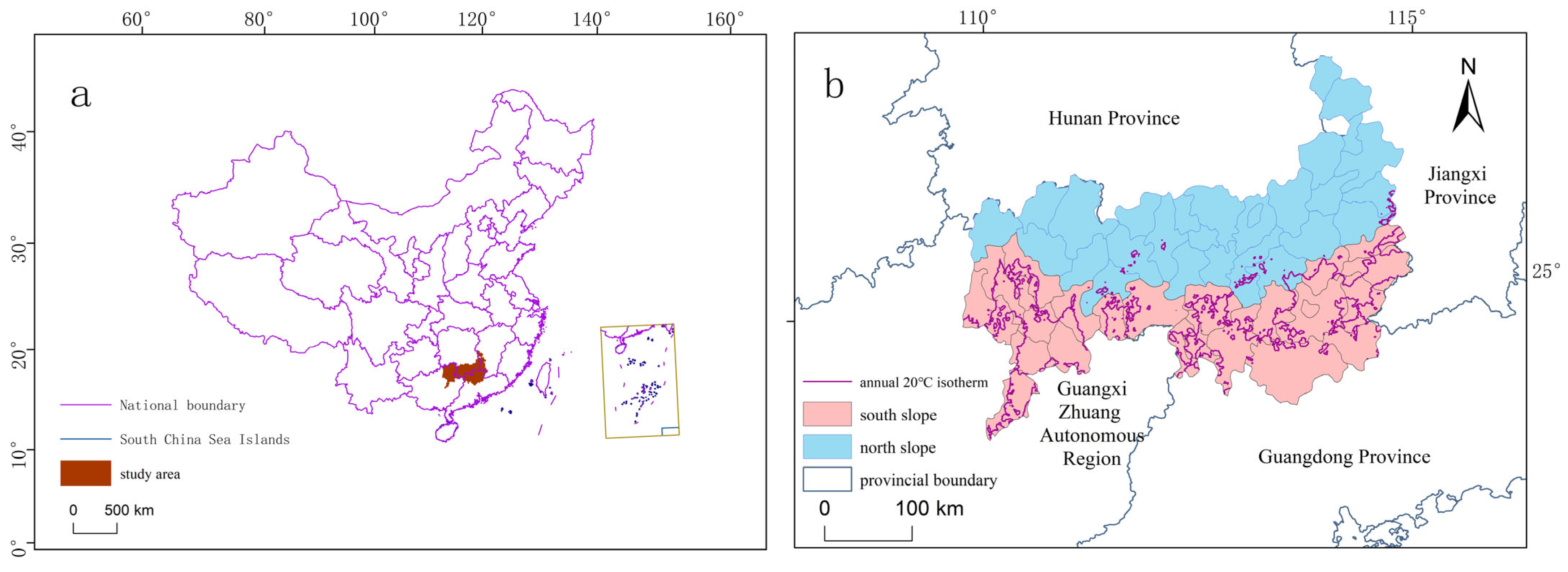
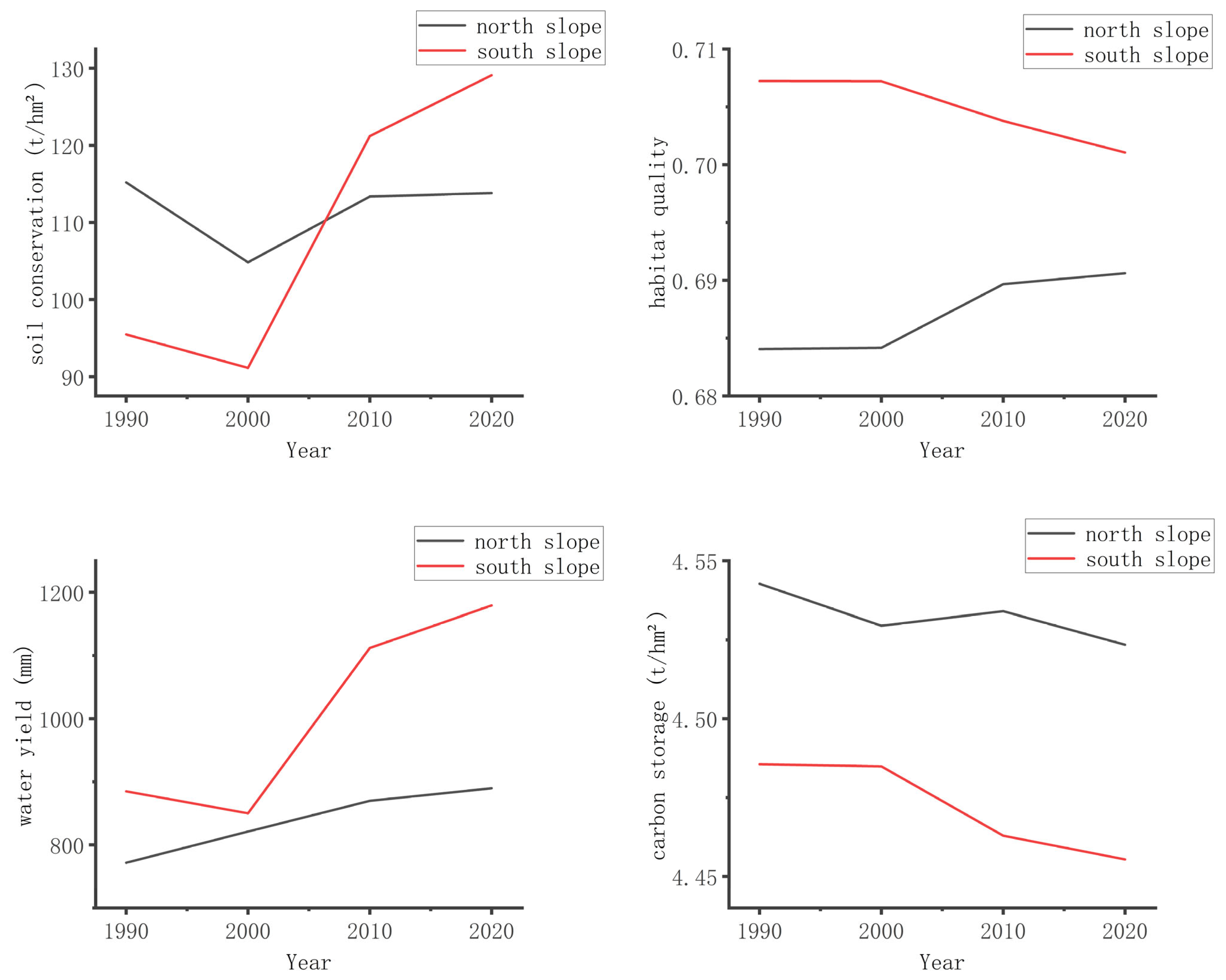
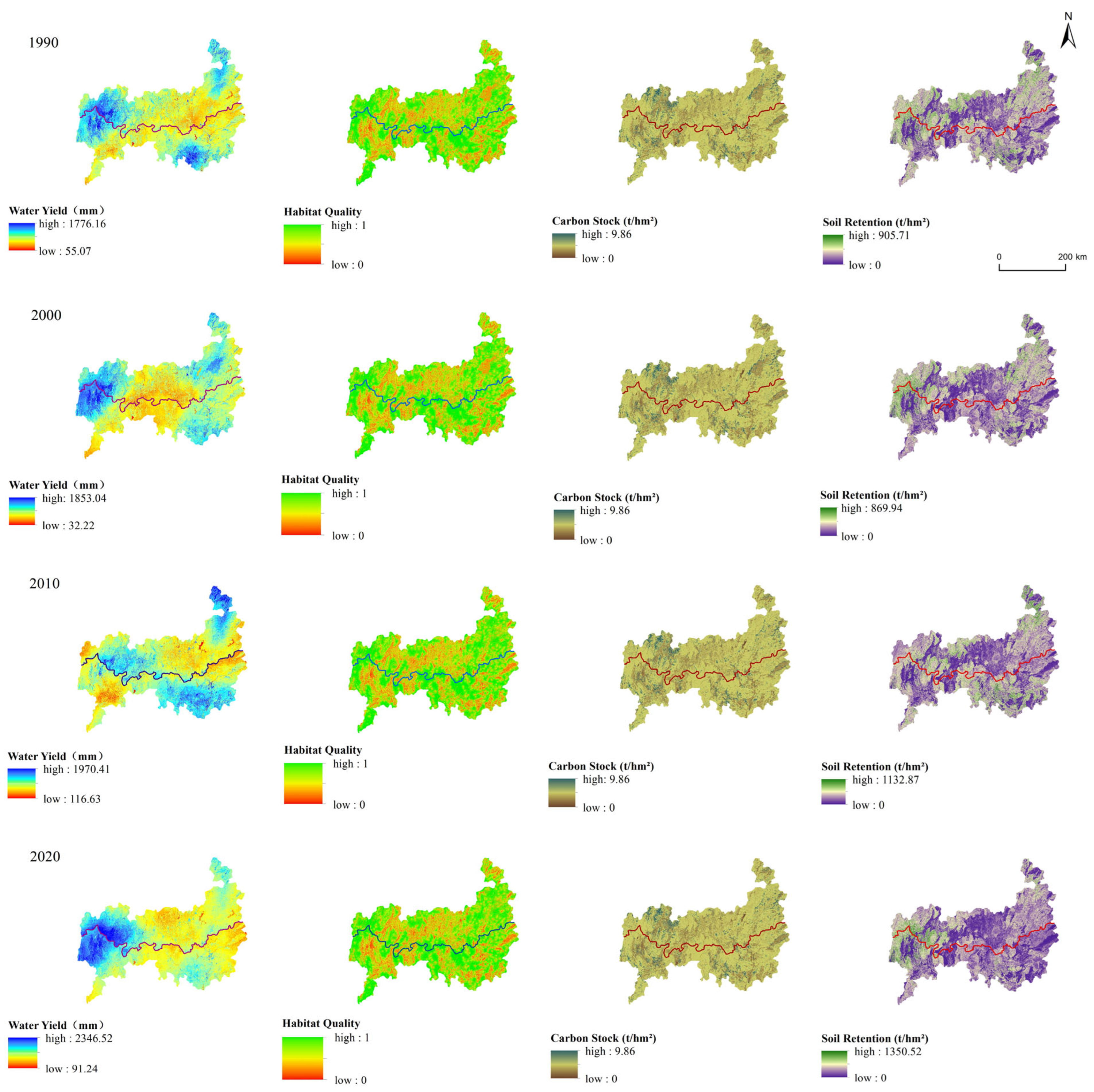


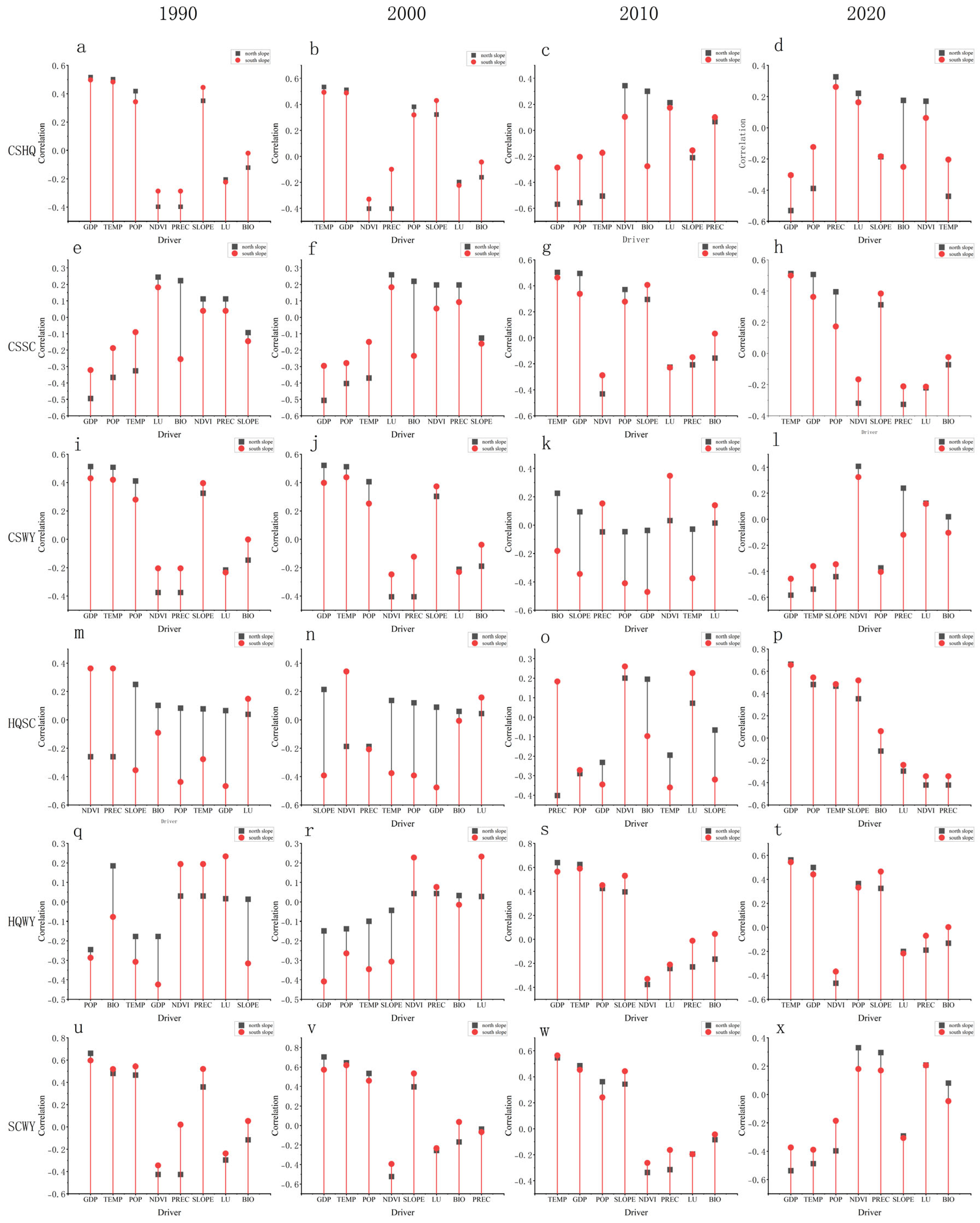
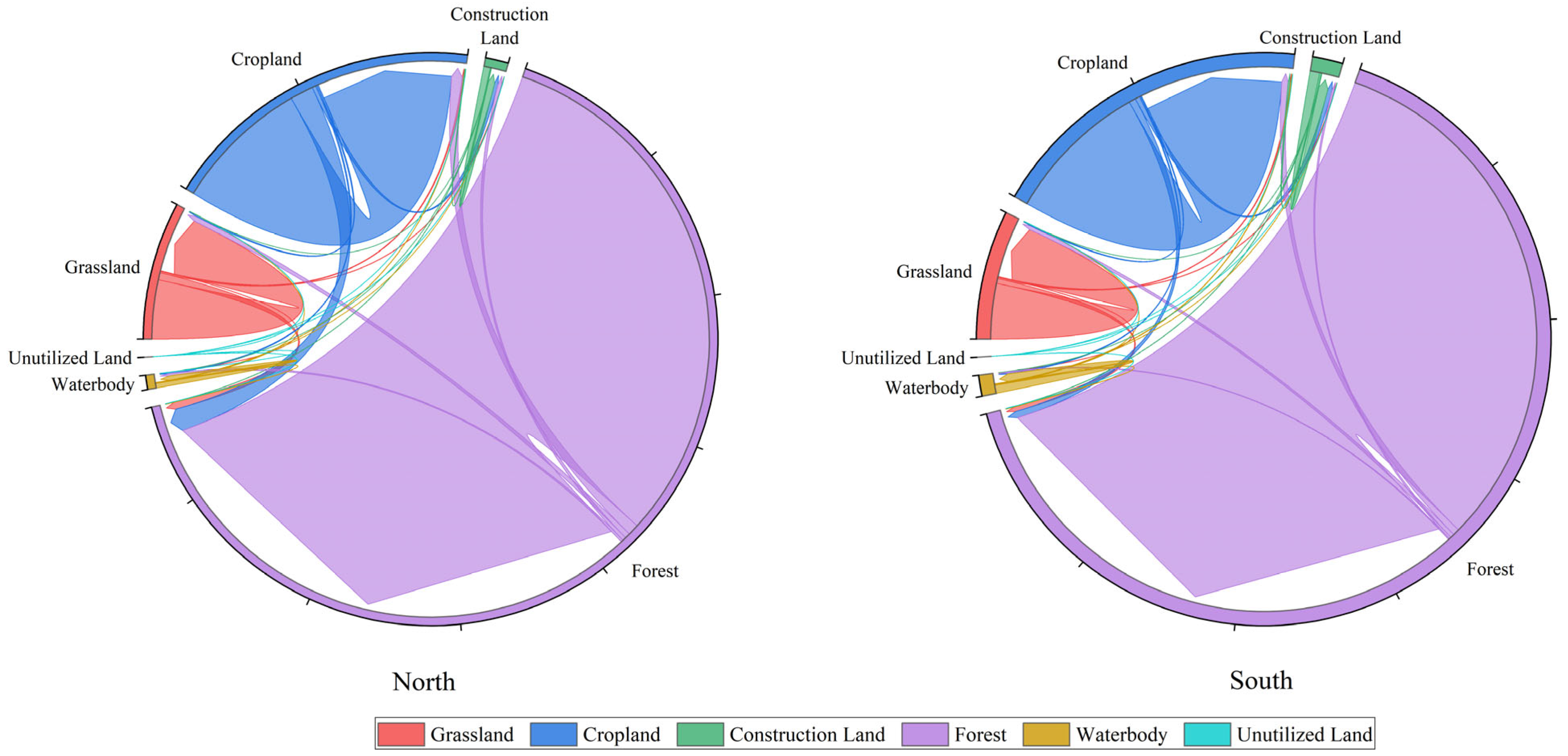
| Data Type | Format | Resolution | Data Source |
|---|---|---|---|
| Monthly precipitation, monthly potential evapotranspiration, monthly temperature | NETCDF | 1 km | National Glacier, Permafrost, and Desert Scientific Data Center (https://www.ncdc.ac.cn/, accessed on 10 May 2025) |
| Root depth | TIFF | 100 m | National Qinghai–Tibet Plateau Scientific Data Center (http://data.tpdc.ac.cn, accessed on 10 May 2025) |
| LUCC | TIFF | 30 m | Center for Resource and Environmental Science and Data, Chinese Academy of Sciences (https://www.resdc.cn/, accessed on 10 May 2025) |
| Basin Boundary | Center for Resource and Environmental Science and Data, Chinese Academy of Sciences (https://www.resdc.cn/, accessed on 10 May 2025) | ||
| DEM | TIFF | 30 m | STRM elevation data (http://srtm.csi.cgiar.org/srtmdata/, accessed on 10 May 2025) |
| Population | TIFF | 1 km | Center for Resource and Environmental Science and Data, Chinese Academy of Sciences (https://www.resdc.cn/, accessed on 10 May 2025) |
| NDVI | TIFF | 1 km | Center for Resource and Environmental Science and Data, Chinese Academy of Sciences (https://www.resdc.cn/, accessed on 10 May 2025) |
| GDP | TIFF | 1 km | Scientific Data (https://www.nature.com/, accessed on 10 May 2025) |
| Irreplaceability Coefficient of Biodiversity | Shp | 1 km | National Ecological Dataset (accessed on 10 May 2025) |
Disclaimer/Publisher’s Note: The statements, opinions and data contained in all publications are solely those of the individual author(s) and contributor(s) and not of MDPI and/or the editor(s). MDPI and/or the editor(s) disclaim responsibility for any injury to people or property resulting from any ideas, methods, instructions or products referred to in the content. |
© 2025 by the authors. Licensee MDPI, Basel, Switzerland. This article is an open access article distributed under the terms and conditions of the Creative Commons Attribution (CC BY) license (https://creativecommons.org/licenses/by/4.0/).
Share and Cite
Zhang, X.; Zhong, K.; Li, R.; Luo, J.; Huang, Y.; Xu, X. Trade-Offs and Synergies of Ecosystem Services and Their Driving Factors on the Northern and Southern Slopes of the Nanling Mountains. Forests 2025, 16, 1634. https://doi.org/10.3390/f16111634
Zhang X, Zhong K, Li R, Luo J, Huang Y, Xu X. Trade-Offs and Synergies of Ecosystem Services and Their Driving Factors on the Northern and Southern Slopes of the Nanling Mountains. Forests. 2025; 16(11):1634. https://doi.org/10.3390/f16111634
Chicago/Turabian StyleZhang, Xinyi, Keyuan Zhong, Rui Li, Jiahui Luo, Yanling Huang, and Xiangming Xu. 2025. "Trade-Offs and Synergies of Ecosystem Services and Their Driving Factors on the Northern and Southern Slopes of the Nanling Mountains" Forests 16, no. 11: 1634. https://doi.org/10.3390/f16111634
APA StyleZhang, X., Zhong, K., Li, R., Luo, J., Huang, Y., & Xu, X. (2025). Trade-Offs and Synergies of Ecosystem Services and Their Driving Factors on the Northern and Southern Slopes of the Nanling Mountains. Forests, 16(11), 1634. https://doi.org/10.3390/f16111634









